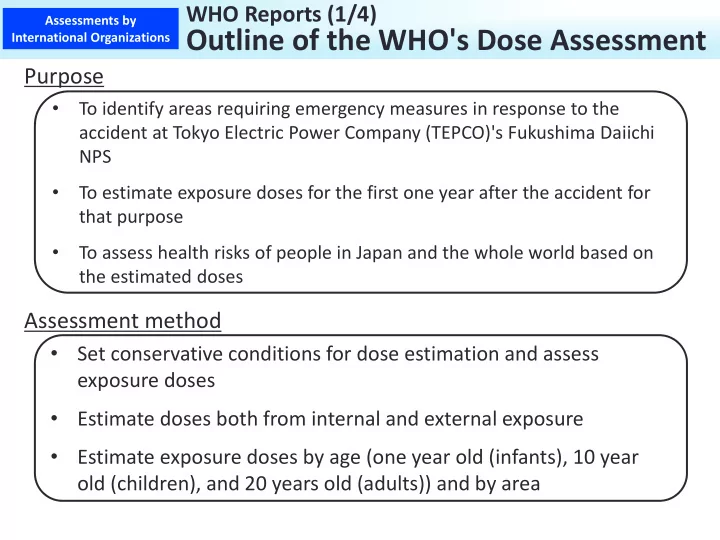

WHO Reports (1/4) Assessments by Outline of the WHO's Dose Assessment International Organizations Purpose • To identify areas requiring emergency measures in response to the accident at Tokyo Electric Power Company (TEPCO)'s Fukushima Daiichi NPS • To estimate exposure doses for the first one year after the accident for that purpose • To assess health risks of people in Japan and the whole world based on the estimated doses Assessment method • Set conservative conditions for dose estimation and assess exposure doses • Estimate doses both from internal and external exposure • Estimate exposure doses by age (one year old (infants), 10 year old (children), and 20 years old (adults)) and by area
WHO Reports (2/4) Assessments by Effective Dose Estimation Method International Organizations Key points of effective dose estimation • Doses due to internal exposure through inhalation and external exposure were calculated based on the measurement data concerning radionuclides deposited on the ground surface. • Doses due to internal exposure through ingestion were calculated based on the measurement data concerning foods. • The 20 km‐zone from the NPS was excluded. • For Deliberate Evacuation Areas, people were assumed to have stayed there for four months after the accident. Exposure pathways All major exposure pathways were taken into consideration. • External exposure from groundshine *1 • External exposure from cloudshine *2 • Internal exposure through inhalation • Internal exposure through ingestion
WHO Reports (3/4) Assessments by Summary of Health Risk Assessment International Organizations Assumptions for risk assessment • Assuming that there is no threshold dose for radiation carcinogenesis, the linear model and the linear quadratic model were adopted for dose‐response relationships for solid cancer and leukemia, respectively. • Dose and dose‐rate effectiveness factors (DDREF) were not applied. Results • People's exposure doses were below all thresholds of deterministic effects. • Even in the area where the highest exposure dose was estimated, no significant increase would be observed in risks of childhood thyroid cancer and other types of cancer or leukemia and increased incidence of these diseases exceeding natural variation is hardly expected. • Risks of hereditary effects due to radiation exposure are further smaller than the risks of generating cancer. • The results suggest that increases in the incidence of diseases attributable to the additional radiation exposure are likely to remain below detectable levels. Conclusion • Values in this Report are for roughly ascertaining current risk levels and are not intended to predict future health effects.
WHO Reports (4/4) Assessments by Evaluation of Uncertainties International Organizations • Uncertainties concerning the estimation of radioactive concentrations in the air based on measured values of radionuclides deposited on the ground surface • Uncertainties concerning compositions and chemical forms of radionuclides • Uncertainties due to a lower assumption of shielding effects of buildings • Uncertainties in internal dose coefficients due to unique metabolism of radioactive materials in Japanese • Uncertainties concerning information on release of radioactive materials (source terms) and the Atmospheric Transport and Dispersion Model (ATDM) simulation • Uncertainties due to assumptions for dose estimation for exposure through ingestion of foods
Recommend
More recommend